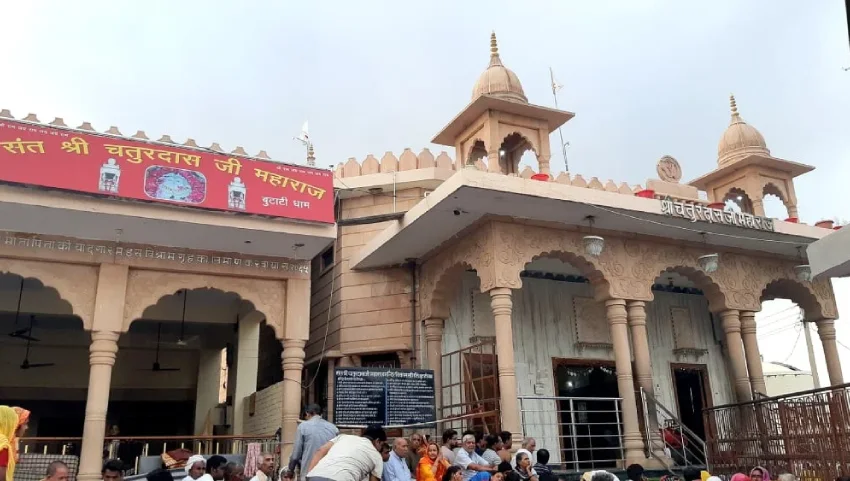
Hanuman Garhi Ayodhya
What's greater than having a devotee who promises to stay behind and protect the place where his deity's childhood to the end of life was spent in this very place of Ayodhya? The time when Hanuman Garhi was given to Lord Hanuman to reside, from that moment till now, it's believed that he protects the place from all evil eyes. Any tourists visiting with the Ayodhya Tour Package, as per rituals, need to visit Hanuman Garhi before going to Ram Mandir.
Hanuman Garhi History
According to the epic saga of Ramayan, after defeating Ravana, upon returning to Ayodhya, Lord Ram and Goddess Sita with Hanuman came back to their homeland. Lord Hanuman stayed in a cave to protect the Land of Ramkot from enemies. As per history reference to Skanda Purana, Hanuman Garhi and other 360 temples were built by King Vikramaditya. Later on, the ruler of Aurangzeb built a Mosque by demolishing The Hanuman Garhi. However, as the year passed, the land was taken back by The Bairag after they defeated the King of Awadh, Nawab Shujauddula, reconstructing the temple of Lord Hanuman again.
It is believed that by taking a holy dip in the River of Saryu, all the sins of people are washed away, after which they get permission from Lord Hanuman to visit their idol, Lord Ram, in Ram Mandir. The construction is done in such a manner that one can see Hanuman Garhi from all sides of Ayodhya. To reach Lord Hanuman, devotees need to climb 76 stairs. Upon reaching it, visitors can see the statue of young Lord Hanuman sitting on the lap of his mother, Mata Anjani. Also, on one side, there is a pillar bought by Lord Hanuman from Lanka to prove the victory over the evil Ravana. The pillar of victory was named Vijay Stambh. Moreover, there is a Tulsi crown made of silver, on which Lord Ram is written, enhancing the place.
Tourists can add other Things to do in Ayodhya, which are visiting the rest of the temples such as Nageshwar Nath, Kanak Bhawan, Sita ki Rasoi, Raja Mandir, and many more. Moreover, one can take a stroll to the Saryu River and appreciate the Gulab Bari, where the surrounding garden is planted with roses, giving the place a magnificent view for tourist attraction.
Hanuman Garhi Aarti Timings
The schedule of prayers differs from season to season, as the prayer timing depends on sunrise and sunset. Thus, during the summer season, the morning prayers are done from 7:30 am to 11:30 am, whereas the evening prayers start from 4:30 pm to 9:30 pm. In the winter season, due to the late sunrise, the worship starts from 9:00 am to 11 am, and the evening rituals begin from 4:00 pm to 9:00 pm.
However, during festivals, there are more rituals, prayers, and gatherings of people to celebrate Lord Hanuman's birthday, due to which the doors of the temple are open till midnight. All festivals, such as Rama Navami, Diwali, and many more festivals, are celebrated with high spirits and amusement among the devotees. For the Ayodhya Tour Guide, tourists should visit the temple during the festive to view the vibrant and colourful nature of the Hindu religion and Indian culture.
Hanuman Garhi Location
Due to the closeness of Lord Hanuman with his idol, Lord Ram, the resident of Lord Hanuman temple, Hanuman Garhi, is situated within 1 km away from Ayodhya Ram Mandir. So that Lord Hanuman can keep an eye on his idol's place to protect him. As per mythology, devotees are encouraged to visit Hanuman Garhi before worshipping Lord Ram in Ram Mandir. The exact location is in Sai Nagar of Ayodhya, on the right side of Saryu Bank of River, in Uttar Pradesh.
Hanuman Garhi Entry Fee
There is no such entry fee to worship their idols; hence, visiting the temple for the Ayodhya Tour for 3 days is free of any charge, making it available and open to all Lord Hanuman devotees.
Tourists planning an Ayodhya Tour from Mumbai can take a flight or train to reach Ayodhya. All roads are well connected and maintained for tourists to travel around for local sightseeing conveniently.
One won't regret picking Ayodhya as their tourist spot for religious tours to know Hindu culture and heritage.

































